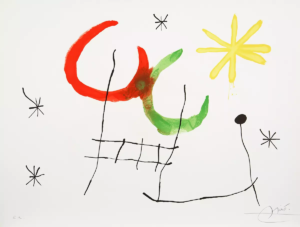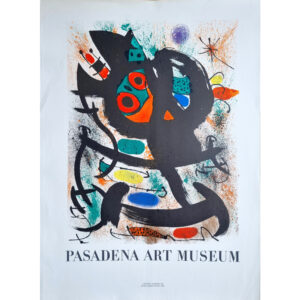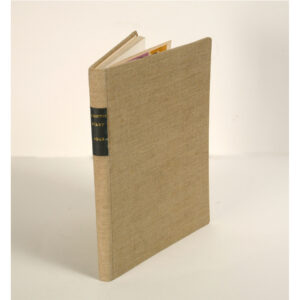Biography
Born in Barcelona in 1893, Joan Miró entered the city's School of Fine Arts in 1907. Forced to stay at the Montroig farmhouse from 1911 onwards due to convalescence, Miró took the opportunity to devote himself to painting. Once he had recovered, he visited the exhibitions of the French avant-garde, which had a profound influence on his work, particularly the Cubist and Fauvist aesthetics. He moved to Paris in 1920. Here he made friends with
Pablo Picasso and
André MassonHe moved closer to the Dadas and joined the Surrealists. His works are particularly remarkable for their humorous dreamlike quality, such as
Insect Dialogue (1924) and
Dog barking at the moon (1926).
In the '30s, Miró produced his first lithographs, then returned to Barcelona and experimented with a new, more abrupt style: using a variety of materials, he produced sculptures, and his works testify to his concern for Spain, notably the "Help Spain" poster produced in 1937. He was forced to move to France during the Spanish Civil War, where he produced the series
Constellations in gouache.
During his stay in the United States at the end of the 40s, he tried his hand at monumental painting, then turned to "spontaneous painting", composed of splashes and stains, based on plays of opacity and texture, such as
The Wall of the Sun. He painted the
Blue in 1961 and received numerous commissions, including one for the UNESCO building in Paris. He is also interested in ceramics and sculpture in marble and bronze, using salvaged objects as for
The Wind Clock produced in 1967. His paintings, influenced by the American masters, became larger and tended towards abstraction; his work thus became more stripped down over the years, but remained marked by its dreamlike quality and rigor. In 1976, the Miró Foundation was inaugurated in his hometown, honoring his work and creativity. His last works were gigantic statues, notably the one in Barcelona, dated 1982. He died in Majorca in 1983.












